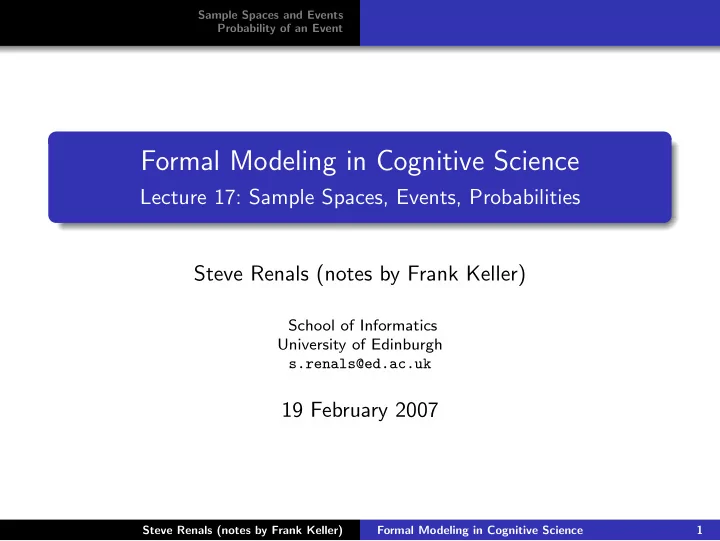

Sample Spaces and Events Probability of an Event Formal Modeling in Cognitive Science Lecture 17: Sample Spaces, Events, Probabilities Steve Renals (notes by Frank Keller) School of Informatics University of Edinburgh s.renals@ed.ac.uk 19 February 2007 Steve Renals (notes by Frank Keller) Formal Modeling in Cognitive Science 1
Sample Spaces and Events Probability of an Event 1 Sample Spaces and Events Sample Spaces Events Venn Diagrams 2 Probability of an Event Axioms of Probability Rules of Probability Addition Rules Steve Renals (notes by Frank Keller) Formal Modeling in Cognitive Science 2
Sample Spaces Sample Spaces and Events Events Probability of an Event Venn Diagrams Terminology Terminology for probability theory: experiment: process of observation or measurement; e.g., coin flip; outcome: result obtained through an experiments; e.g., coin shows tail; sample space: set of all possible outcomes of an experiment; e.g., sample space for coin flip: S = { H , T } . For now, we will only deal with discrete sample spaces (i.e., sample spaces whose elements can be mapped the set of integers). Steve Renals (notes by Frank Keller) Formal Modeling in Cognitive Science 3
Sample Spaces Sample Spaces and Events Events Probability of an Event Venn Diagrams Terminology Example: Finite Sample Space Roll two dice, each with numbers 1–6. Sample space: S 1 = { ( x , y ) | x = 1 , 2 , . . . , 6; y = 1 , 2 , . . . , 6 } Alternative sample space for this experiment: sum of the dice: S 2 = { x | x = 2 , 3 , . . . , 12 } Example: Infinite Sample Space Flip a coin until head appears for the first time: S 3 = { H , TH , TTH , TTTH , TTTTH , . . . } Steve Renals (notes by Frank Keller) Formal Modeling in Cognitive Science 4
Sample Spaces Sample Spaces and Events Events Probability of an Event Venn Diagrams Events Often we are not interested in individual outcomes, but in events. An event is a subset of a sample space. Example With respect to S 1 , describe the event B of rolling a total of 7 with the two dice. B = { (1 , 6) , (2 , 5) , (3 , 4) , (4 , 3) , (5 , 2) , (6 , 1) } Steve Renals (notes by Frank Keller) Formal Modeling in Cognitive Science 5
✲ ✵✶ ✾ ✽✾ ✽ ✼ ✻✼ ✻ ✺ ✹✺ ✹ ✸ ✷✸ ✷ ✶ ✵ ✿❀ ✴ ✳✴ ✳ P◗ ✱✲ ✱ ✰ ✯✰ ✯ ✮ ✭✮ ✭ ✬ ✿ ❀ ✫ ❋ ◆❖ ◆ ▼ ▲▼ ▲ ❑ ❏❑ ❏ ■ ❍■ ❍ ● ❋● ❊ ❁ ❉❊ ❉ ❈ ❇❈ ❇ ❆ ❅❆ ❅ ❄ ❃❄ ❃ ❂ ❁❂ ✫✬ ✪ P ✝✞ ✍✎ ✍ ✌ ☞✌ ☞ ☛ ✡☛ ✡ ✠ ✟✠ ✟ ✞ ✝ ✏ ✆ ☎✆ ☎ ✄ ✂✄ ✂ ✁ �✁ � ◗ ❘ ❘❙ ❙ ✎ ✏✑ ✩✪ ✑ ✩ ★ ✧★ ✧ ✦ ✥✦ ✥ ✤ ✣✤ ✣ ✢ ✜✢ ✜ ✛ ✚✛ ✚ ✙ ✘✙ ✘ ✗ ✖✗ ✖ ✕ ✔✕ ✔ ✓ ✒✓ ✒ ❖ Sample Spaces Sample Spaces and Events Events Probability of an Event Venn Diagrams Events The event B can be represented graphically: die 2 6 5 4 3 2 1 die 1 1 2 3 4 5 6 Steve Renals (notes by Frank Keller) Formal Modeling in Cognitive Science 6
Sample Spaces Sample Spaces and Events Events Probability of an Event Venn Diagrams Events Often we are interested in combinations of two or more events. This can be represented using set theoretic operations. Assume a sample space S and two events A and B : complement ¯ A (also A ′ ): all elements of S that are not in A ; subset A ⊂ B: all elements of A are also elements of B ; union A ∪ B: all elements of S that are in A or B ; intersection A ∩ B: all elements of S that are in A and B . These operations can be represented graphically using Venn diagrams. Steve Renals (notes by Frank Keller) Formal Modeling in Cognitive Science 7
Recommend
More recommend